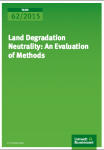A study commissioned by the German Federal Environment Agency (UBA) and carried out by the ISRIC - World Soil Information based in Wageningen, The Netherlands, entitled ‘Land Degradation Neutrality: An examination of methods,' provides a critical review of major land and soils assessments undertaken since the 1970s.
The study notes that there has been no “truly global, land based assessment” since 1990, despite the demand for such data, and expresses hope that the Sustainable Development Goals (SDGs) target on Land Degradation Neutrality (LDN) will help generate momentum for a universally-agreed conceptual framework and “the beginning of a global monitoring effort to better understand trends of soil degradation and improvement over time.”
 November 2015: A study commissioned by the German Federal Environment Agency (UBA) and carried out by the ISRIC – World Soil Information based in Wageningen, The Netherlands, entitled ‘Land Degradation Neutrality: An examination of methods,’ provides a critical review of major land and soils assessments undertaken since the 1970s. The study notes that there has been no “truly global, land based assessment” since 1990, despite the demand for such data, and expresses hope that the Sustainable Development Goals (SDGs) target on Land Degradation Neutrality (LDN) will help generate momentum for a universally-agreed conceptual framework and “the beginning of a global monitoring effort to better understand trends of soil degradation and improvement over time.”
November 2015: A study commissioned by the German Federal Environment Agency (UBA) and carried out by the ISRIC – World Soil Information based in Wageningen, The Netherlands, entitled ‘Land Degradation Neutrality: An examination of methods,’ provides a critical review of major land and soils assessments undertaken since the 1970s. The study notes that there has been no “truly global, land based assessment” since 1990, despite the demand for such data, and expresses hope that the Sustainable Development Goals (SDGs) target on Land Degradation Neutrality (LDN) will help generate momentum for a universally-agreed conceptual framework and “the beginning of a global monitoring effort to better understand trends of soil degradation and improvement over time.”
Following an introductory section, the report critically reviews the methodology and results of four global land and soil assessments, since the first assessment of the state of the world’s drylands prepared for the 1977 UN Conference on Desertification (UNCOD). These are: the Global Assessment of Human-induced Soil Degradation (GLASOD), which was the first study to assess soil degradation beyond the drylands, and was led by ISRIC-World Soil Information from 1987-1990; the Millennium Ecosystem Assessment (MA), carried out between 2000-2005 under the coordination of the UN Environment Programme (UNEP); the Global Assessment of Land Degradation and Improvement (GLADA), funded by the Global Environment Facility (GEF) and led by ISRIC-World Soil Information from 2006-2009; and the Global Land Degradation Information System (GLADIS), which took place from 2009-2011 under the leadership of the Food and Agriculture Organization of the UN (FAO).
The report also mentions several ongoing or proposed global analyses and assessments, including the global thematic assessment on land degradation and restoration by the Intergovernmental Platform on Biodiversity and Ecosystem Services (IPBES), the third edition of the World Atlas of Desertification (WAD), the Status of the World Soil Resources report of the FAO’s Global Soil Partnership (GSP), and the UN Convention to Combat Desertification (UNCCD) World Land Outlook report. It concludes that, as desktop studies, they “are not likely to involve a substantial amount of groundtruthing.”
The next section of the report discusses the main approaches used to map global land degradation, including expert-based or qualitative assessments, remote sensing-based assessments, and modelling approaches. Noting that no single approach can adequately tackle the multi-dimensional, multi-scale, transitional, multi-perspective, and multi-actor nature of land degradation, the report describes the main challenge as finding “reproducible, globally applicable ways in which the various scales can be bridged” by applying the different methodologies, and that, so far, it has not been possible to reconcile expert-based (“bottom-up”) information with remote sensing (“top-down”) approaches “for an ultimate global assessment.” It calls for future assessments to, inter alia: adopt an agreed conceptual framework; show respect for complexity and diversity; follow an ecosystem approach; and ensure adequate funding.
The final chapter reviews the lessons learned from previous endeavors to identify promising elements for future land degradation assessments at the global level. In view of the need for local solutions to achieve the LDN target, the report calls for future assessments to move beyond a focus on “the damage done,” by examining “the many promising sustainable land management (SLM) technologies and approaches that are already applied.” It highlights the World Overview of Conservation Approaches and Technologies (WOCAT) database, introduced in the mid-1990s and still in use today, as an example of how to demonstrate “the ‘good news’ side of things,” noting it could play an important role in future land degradation assessments. [UBA Announcement] [Publication: Land Degradation Neutrality: An Evaluation of Methods]